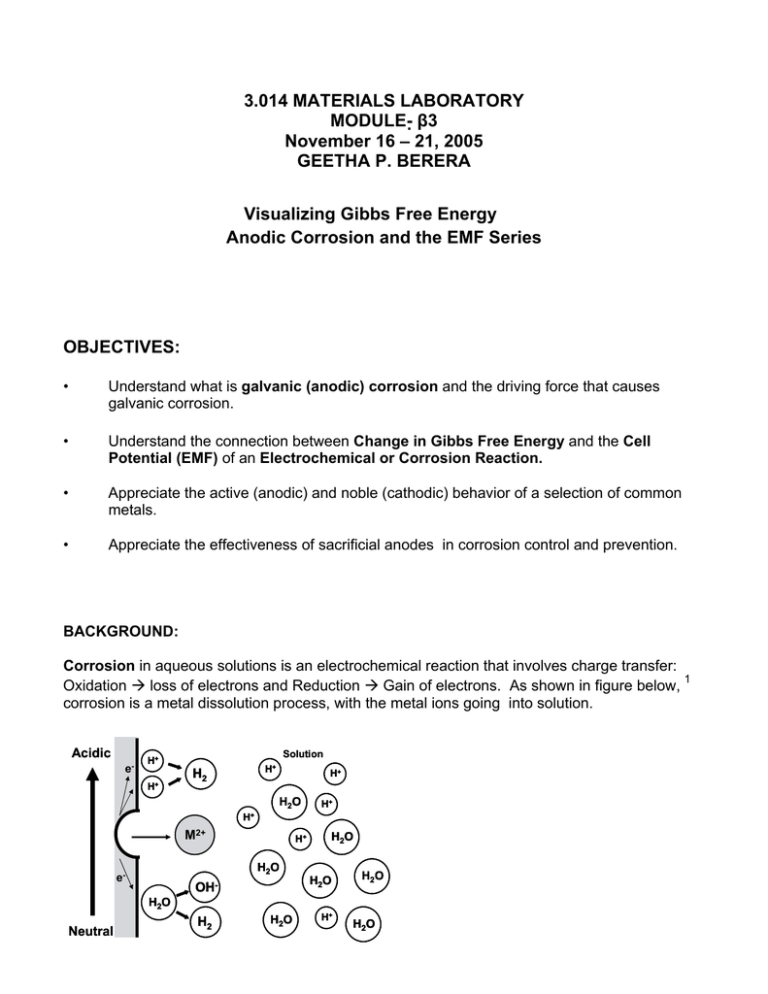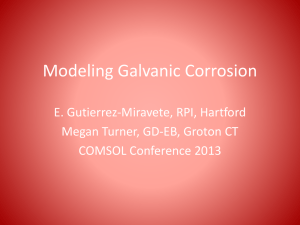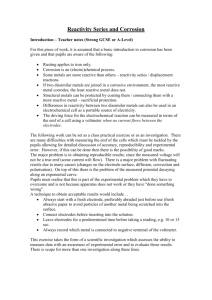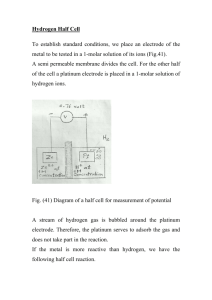3.014 MATERIALS LABORATORY MODULE- β3 November 16 – 21, 2005 GEETHA P. BERERA
advertisement

3.014 MATERIALS LABORATORY
MODULE- β3
November 16 – 21, 2005
GEETHA P. BERERA
Visualizing Gibbs Free Energy
Anodic Corrosion and the EMF Series
OBJECTIVES:
•
Understand what is galvanic (anodic) corrosion and the driving force that causes
galvanic corrosion.
•
Understand the connection between Change in Gibbs Free Energy and the Cell
Potential (EMF) of an Electrochemical or Corrosion Reaction.
•
Appreciate the active (anodic) and noble (cathodic) behavior of a selection of common
metals.
•
Appreciate the effectiveness of sacrificial anodes in corrosion control and prevention.
BACKGROUND:
Corrosion in aqueous solutions is an electrochemical reaction that involves charge transfer:
1
Oxidation Æ loss of electrons and Reduction Æ Gain of electrons. As shown in figure below,
corrosion is a metal dissolution process, with the metal ions going into solution.
Acidic
e-
H+
H+
Solution
H+
H2
H+
H2O
H+
H+
M2+
H+
H2O
e-
OH-
H2O
H2O
H2O
H2O
Neutral
H2
H2O
H+
H2O
Oxidation or Anodic Reaction
M Æ Mn+ + ne(Fe Æ Fe2+ + 2e-)
(Zn Æ Zn2+ + 2e-)
The reduction reactions depend on the type of environment.
Typical Reduction or Cathodic Reactions are:
Hydrogen
2H+ + 2e- Æ H2 (acidic solutions)
Oxygen
O2 + 4H+ + 4e- Æ 2H2O (acidic solutions)
O2 +2H2O + 4e- Æ OH- (neutral/basic solutions)
Water
2H2O + 2e- Æ H2 +OH- (neutral/basic)
Corrosion measurements are quantified by constructing a corrosion cell (an electrochemical
cell) as shown below.
ELECTROCHEMICAL CELL
E
e-
anion flow
-
+
cation flow
Electrolyte
Anode: Oxidation reaction site (negative)
Cathode: Reduction reaction site (positive)
E: Cell Potential or Cell EMF
Cathode (reduction)
Anode (oxidation)
C
+
The cell potential is a measure of the tendency of a metal to corrode.
Relationship between Gibbs Free Energy and the Cell Potential: 1,2
From thermodynamic considerations, one can assert the tendency of a metal to corrode. The
change in Gibbs Free Energy predicts whether or not, a corrosion reaction occurs
spontaneously. ∆G < 0. The change in free energy can be calculated from a measurement of
the cell potential.
The maximum amount of electrical energy (or work done) that can be delivered, by an
electrochemical cell in a given state is nFE, depends on the change in Gibbs Free Energy, ∆G
as shown in equation 1.
∆G = - nFE
(1)
where n is the number of moles of electrons exchanged in an electrochemical reaction, F is the
Faraday’s constant (96,485 C / mole), and E is the cell potential in a given sate.
For cell conditions, in a standard state,
∆G
0
0
= - nFE
0
(2)
0
where, E represents standard electrochemical cell potential, and ∆G represents the Gibbs
Free Energy changes in the standard state. The standard Electromotive Force (EMF) series of
1,2
0
Metals shown in text books
represents E .
How the cell potential varies with the cell conditions is established by the Nernst
equation. The Nernst equation is a fundamental equation in electrochemical reactions which
expresses the electrochemical cell potential in terms of reactants and products of the reaction.
2
It can be derived based on Gibbs Free Energy Criterion for chemical reactions.
For a general chemical reaction, the changes in Gibbs Free Energy is related to the
reactants and products of reaction, as shown in equations 3 and 4.
0
∆G - ∆G = RT ln [ a products / a reactants]
(3)
or
0
∆G - ∆G = 2.303 x RT log[ a products / a reactants]
(4)
0
where, ∆G and ∆G , represent changes in the free energy of products and reactants in nonstandard and standard states, respectively, R is the gas constant (8.314 J/deg.mole), T is the
absolute temperature, a products and a reactants are the activities (related to concentration) of
products and reactants, respectively.
Equations, 3, 4 and 6, establishes the NERNST equation, which relates the cell potential in any
state, to the cell potential in a standard state, and the products and reactants of the
electrochemical reaction.
0
E – E = - [2.303 x RT / nF] x {log[ a products / a reactants]}
Or
0
E=E
- [2.303 x RT/nF] x { log[ a products / a reactants]}
(5)
(6)
Though the thermodynamic aspect is useful in determining the relative tendencies of metal
reactivity (or corrosion), in practical situation, the kinetics of a corrosion reaction is important in
asserting the extent to which a metal corrodes, i.e, the rate of corrosion. The corrosion rate is
proportional to corrosion current. (This will be the subject of study next semester). Thus, a
definite way of knowing if a metal in a given environment is corroding, is to make a current
measurement.
MATERIALS
Selection of metal strips.
A piece of scrap iron
Steel (1018)
Commercially available aluminum foil.
Darkened silver item.
3% sodium chloride (NaCl) solution. “synthetic sea water”
5% Sodium bicarbonate solution (baking soda)
EQUIPMENT
Multimeters (voltmeter, ammeter)
Beakers
Clamps on plastic mount to fit into beakers.
Adjustable power supply
Hot plate
EXPERIMENTAL TASKS:
1.
3
GALVANIC CELL POTENTIAL and GALVANIC SERIES
Construct a galvanic cell between two dissimilar metals in synthetic “seawater,”
Measure the cell electromotive force (emf) or potential between the two metal strips ,
measuring each metal strip one at a time. Pick the copper strip as one of the electrodes
(CATHODE, POSITIVE) for all measurements and change the metal strip of the other
electrode from the available set of metal strips.
The “seawater” will be simulated using a 3% sodium chloride (NaCl) solution.
Establish a galvanic series by ordering the examined metals according to their emf’s.
Place the more cathodic (noble) metals at the top and active metals at the bottom.
Calculate the Gibbs free energy changes from the measured cell potential.
Lessons to be learned: Predicts which metal is more ANODIC (active) or CATHODIC (noble)
in galvanic corrosion [GALVANIC CORROSION: two metal corrosion: corrosion that occurs
when two metals are coupled together].
The galvanic series can be set up for any given electrolyte. It may differ drastically from
tabulated galvanic series or EMF series and values in textbooks that refer to a measurement
under normalized conditions for given electrolytes and concentrations.
2.
CELL POTENTIAL vs. TIME
Construct a galvanic cell with a zinc-copper couple in synthetic sea water. Measure the
cell potential as a function of time over a period of at least 20 minutes. We will use a
SOLARTRON POTENTIOSTAT for this part of the experiment. Make Copper as the
CATHODE.
Reclean first the zinc electrode and then the copper electrode and note any effect on the
cell potential.
Lessons to be learned: Reaction products formed on the electrode surfaces can affect the
measured cell potential over time.
3.
SILVER CLEANING:
Prepare a 5% sodium bicarbonate (baking soda) solution in a 200 mL beaker. Take a
piece of aluminum foil, crumple and stress it a bit to damage the native, passivating oxide
layer thereby exposing the base metal.. Wrap a tarnished silver item (jewelry) with the
foil and place the foil inside the bottom of the beaker . Heat the solution for 2h at
60 – 80 oC.
Lessons to be learned: The case of electrical contact between two different metals placed in
an electrolyte is called a galvanic element. It results in the oxidation and dissolution of the less
noble metal. The more noble metal covered with an oxide, or some other similar layer, can be
reduced to the bare metal again if the cell potential is high enough, as it is for this case.
4.
ELECTRODE SIZE EDDECTS ON CORROSION POTENTIAL AND CURRENT:
Construct a cell with a piece of Brass (CATHODE) and piece of Zinc (ANODE). Measure
the emf and cell current for brass and zinc for different sample areas.
Lessons to be learned: Current is proportional to the electrode area, and is a measure of
corrosion rate. The potential is independent of the size of the electrode.
5.
SACRIFICIAL ANODES:
A.
ZINC as a SACRIFICIAL ANODE:
Prepare a galvanic couple between steel 1018 or iron as an ANODE and copper, as
a cathode. Measure the emf and current of the cell. Add to the cell a third electrode
(zinc electrode) that is connected electrically to the steel. or iron . Measure the cell
potential and current , also the current between steel and zinc. Note the changes in
the corrosion behavior in the cell.
B. SCRAP STEEL or IRON as a SACRIFICIAL ANODE:
Prepare a galvanic couple between steel 1018 or iron as an ANODE, and a copper
strip as a CATHODE. Measure the emf and current of the cell. Add a piece of scrap
steel (1018) or iron as the third electrode. Insert a dc power supply into the circuit
with the third electrode ANODIC relative to the initial steel 1018 electrode. Record
the voltage that diminishes the current flowing through the first steel, indicating the
corrosion control on the first steel.
Lessons to be learned: Sacrificial anodes can be inserted in different ways into materials that
can become subjected to corrosion currents.
REFERENCES:
1.
M.G. Fontana and N.D.Greene, Corrosion Engineering, 2rd ed., McGraw-Hill, NY (1984).
2.
H. H . Uhlig, “Corrosion and Corrosion Control”, 2nd edition, page 18-21, Wiley, New York,
1971.
3.
E.C. Subbarao et al., Experiments in Materials Science, Ch. 14, McGraw-Hill, NY (1961).
(handed out)
Reading List:
E.C. Subbarao et al., Experiments in Materials Science, Ch. 14, McGraw-Hill, NY (1961).
(handed out)
J. Wulff, et al., Structure and Properties of Materials, Vol. II, Thermodynamics of Structure,
Wiley, NY (1966). (handed out)
M.G. Fontana and N.D.Greene, Corrosion Engineering, 2rd ed., McGraw-Hill, NY (1984).
(handed out)
J.C. Scully, The Fundamentals of Corrosion, 3rd ed., Pergamon, NY (1990).





